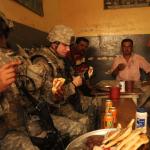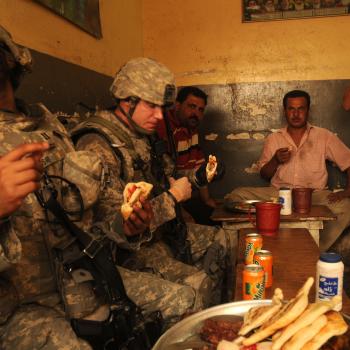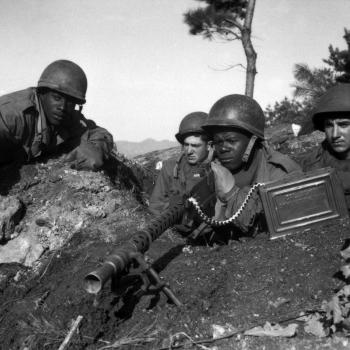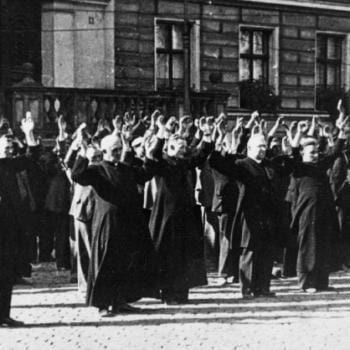Okay, dear readers, it’s time we had a talk about cultural appropriation. No, I’m not talking about what you think I am; I’m talking about Catholic men who get all excited about comparing spiritual warfare to actual warfare, who militarize their own faith. Yes, I’m aware that the Church already has a fair bit of militarism about it, with the whole battle between heaven and hell, Saint Michael, and so on.
I’m not talking about that; I’m talking about the ones for whom the phrase “church militant” actually just means “militant.” The ones who are obsessed with the trappings of war, the medieval Catholic Church, and overweening masculinity. Why do these men – and I say men because it’s rare to find women peddling this schtick – feel the need to militarize the trappings of their spirituality?
The Gear
First off, let’s start with the gear. Honestly, what kicked this post off was the discovery of the “Gun Metal Patriot Combat Rosary” being sold online by one of the many purveyors of religious stuff. This one’s a doozy, folks. Made by a Father Richard Heilman of Wisconsin, this rosary has been designed to – and this is an actual quote – “use the most powerful of sacrementals by adding the Benedict Medal and Pardon Crucifix, which makes it a powerful spiritual assault weapon against evil forces.”
What makes it a “patriot” rosary? It’s got a little medallion of the U.S. on it in order to “Make America Holy Again.” Oh, and it comes in a “cool Spiritual Ammo Tin.”

There’s a lot to unpack here.
First off, I doubt that God cares too much about nation states. There’s a shocking lack of nice things said about them in the gospel. Second, the idea that one’s prayers are somehow more efficacious if said while holding different kinds of medals really makes one wonder how some of the great saints of the Catholic Church managed to actually gain their sainthood without such marvelous devices. And if a platoon of demons is somehow put off by the gear of their target, then I don’t think they’re very effective demons.
These are the people who took the whole Ephesians 6 bit about the armor of God literally (incidentally, Ephesians 6:5 is where Paul tells slaves to be obedient to their earthly master; sure, he tells masters to be nice too, but one gets the feeling that was broadly interpreted).
Never mind that for actual combat this piece of metal is worse than useless, since the metallic jingling completely blows all noise discipline. If you actually want to be tactical, use a wooden rosary or one of those free plastic ones that the chaplain always hands out. I’m pretty sure your prayers will shoot just as straight. If Jesus cares more about the make of your rosary than the intentions behind it, then you might not have the right Jesus.
Also, we in the military already have a combat rosary. Two, actually. The one are the hands that God gave you that you always have on you. The other is the set of ranger beads you have to count your paces. If you can’t manage a good couple decades between those two while trying to stay awake on a ruck march at night, well then I don’t know what to do with you.
As an entertaining aside, Father Heilman has established the “U.S. Grace Force,” the newest branch of the U.S. Armed Forces; with responsibility for warfare in the spiritual realms. That’s all from his website; I wrote that with a straight face, can you believe it? Seems like he’s pushing for his own combatant command over there in Wisconsin.
Militarized Lingo
The other weird schtick is the adoption of military terminology. As we saw above “assault” and “combat” are some favorite terms. There’s no lack of “badass” videos about putting on the armor of God on YouTube. Then there’s this Father John Zuhlsdorf (who warns a “feminized Church is a weak institution. It puts soft devotions ahead of the Cross”), who wrote a rosary-based running cadence. No, not a useful one, for when you’re actually running and need something rhythmic and repetitive such as the rosary to modulate your breathing; no, a motivational rosary cadence. Here it is, in all its…well, have a read.
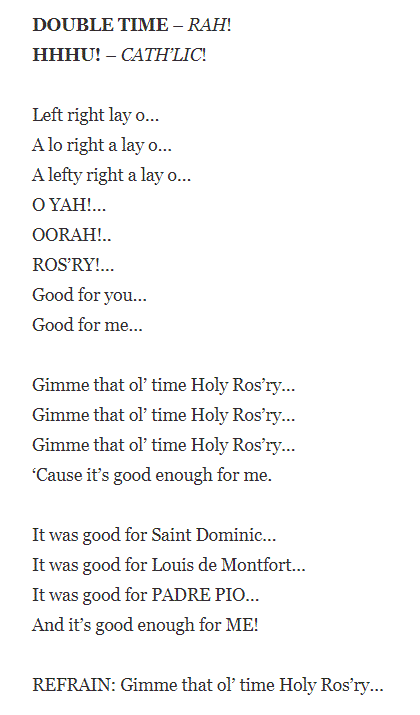
And that’s just a snippet. It goes on for some time.
For some reason, all these dudes love the Marine Corps, too. You rarely find militant Catholics using Air Force or Navy speak. It’s a weird blend of machismo and misplaced anxiety about their role in the world.
The Reason
So what is it about these men – many of them priests – who have such an obsession with the military? Or rather, with aspects of the military but not the military itself? Because one thinks they could have just joined; where they would have found that the military is more rules and paperwork than chest-thumping, as the rest of us found. Incidentally, the same goes for the Catholic Church.
No, they like the militant overtones, the trappings of war without the fear of imminent and horrific violence. It makes them feel empowered by the perceived virtue of their cause.
It’s nothing new. Militarization occurs everywhere in society. Even within the military you get people who buy all the latest gear and gadgets in order to look “tacticool.” Are they efficient and effective? Not usually. These geardos obsess over the accouterments of war, not the function of it. Much like those who espouse a militancy in their fervor for their religion.
There’s a darker reason behind the “church militancy,” and it comes in the form of the “otherism” that turning religion into spiritual warfare brings with it. It allows the one side to paint themselves as standing in the absolute right; God is on their side (Lord, where haven’t You heard that before?); the Lord goes before them, so who can stand against them?
There’s an old military adage that the enemy has a say about when a conflict ends. So too, God has a say on which side He joins on. And I rather think He does not take delight in the wholesale slaughter of His daughters and sons. Nor the glorification of it in His name.
Real Heroes
But if you are actually someone who finds that military analogies work for you, our own U.S. military history has two incredible role models for you.
Father Vincent Capodanno (Lieutenant, U.S. Navy) ministered to men of the 5th Marines in Vietnam in 1967 during a fierce fight near Dong Son. He repeatedly exposed himself to enemy fire to give aid – both medical and spiritual – to wounded Marines. In this effort, he was twice wounded but refused treatment. Spotting a corpsman who had fallen outside the perimeter, attempting to treat two wounded Marines, he ran to the young men. As he provided aid to the corpsman, shielding him with his own body, Father Capodanno was cut down by machine gun fire.
The former Maryknoll missionary to China was posthumously awarded the Medal of Honor in 1969.
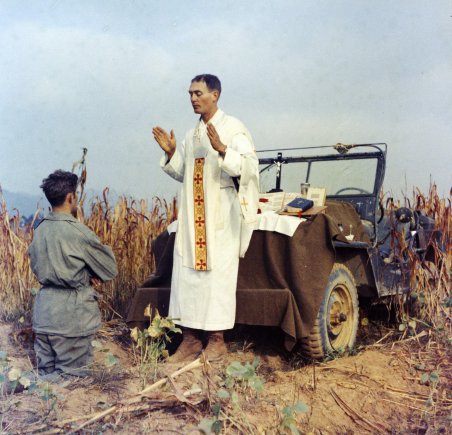
Father Emil Kapaun (Captain, U.S. Army) was serving with 3rd Battalion, 8th Cavalry Regiment during the Korean War when his element was overrun by Chinese soldiers and had to retreat. Kapaun, who had been helping move the wounded to the casualty collection point, volunteered to stay with the wounded and now found an injured Chinese officer and negotiated for the safe surrender of the U.S. troops. He also placed himself between one Chinese soldier and one Sergeant First Class Herbert Miller, preventing the enemy soldier from executing the sergeant.
In captivity, Kapaun helped the soldiers resist the emotional manipulation of their Chinese captors, kept them active with small acts of disobedience of defiance, worked to keep a coherent command structure in place (destroying this was one of the ways that the Chinese could break prisoners), mediated disputes, and generally kept up morale. He gave away his own food to fellow prisoners as well.
Father Kapaun developed a blood clot in one of his legs, along with a myriad of other illnesses, and weakened quickly in early 1951. He was removed by the prison guards and left alone to die of malnutrition and pneumonia, which he did on May 23, 1951. He was placed in a mass grave.
On April 11, 2013, President Obama upgraded his Distinguished Service Cross to the Medal of Honor.
Both men are also on the list for possible canonization. One thing is very clear about both of them. Both were humble servant leaders. Both lived the gospel of Christ, and died living it: “Love one another as I have loved you.”
There were no chest-thumping speeches; no cool gear made them invulnerable in battle. They simply lived the Gospel, and when necessary, used words, as Saint Francis of Assisi said.
Let’s have more of that, and less “patriot combat rosaries.”
Enjoy what you just read? Please share on social media or email utilizing the buttons below.
About the Author: Angry Staff Officer is an Army engineer officer who is adrift in a sea of doctrine and staff operations and uses writing as a means to retain his sanity. He writes at The Angry Staff Officer. He also collaborates on a podcast with Adin Dobkin entitled War Stories, which examines key moments in the history of warfare.
Cover image: “Urban targets” by Gianni Dominici


